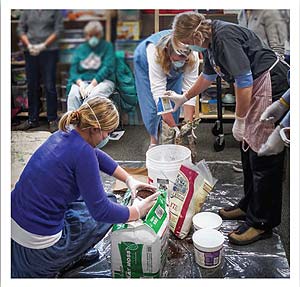Radical Home Economics | Programs That Pop
Radical Home Economics (RHE) revives homemaking skills for adults. In this hands-on series (the messier, the better!), participants work together to make things that are meaningful in their everyday lives. Projects have included natural cleaners, hypertufa (faux stone) pots, cocoa mix, and spa products, among others. I focus on projects that might be intimidating for solo learners, such as those that misleadingly appear expensive or involve unfamiliar ingredients or technology. Perhaps our grandmothers never dreamed of wiring LED holiday cards, but they knew all about the power of handcrafting to make our lives more affordable, greener, and healthier.
The deep importance of Maker programming goes far beyond entertainment—even beyond the practical use of the project. RHE is a fresh and exciting take on one of the library’s oldest and most fundamental purposes. The real power behind lending books is the conviction that you can be your own expert; you are empowered to do and create and think anything you can imagine. Maker programming shares this purpose. In a culture where everything is increasingly commoditized and prepackaged, access to this foundational library value is increasingly rare, valuable, and transformative. It is nothing short of radical.
How it works
RHE meets quarterly for an hour on Saturday mornings, a time convenient for working adults. Attendance ranges from ten to 20 participants, with advanced registration encouraged. Because these programs are messy and communal, they cannot easily accommodate larger groups. I provide all the materials and supplies, with the cost averaging $50–$75.
I measure success primarily by attendance but secondarily by anecdotes and enthusiasm. By the end of each program, members are often already making plans to try larger projects or teach other people. Some send me photos; many return for future programs in the series.
Want to give it a whirl? Try my most popular program, making hypertufa pots (below).
The secret
The key to success is that the participants finish what they start. Having a completed product to take home is exciting and satisfying. It gives people a sense of accomplishment that inspires them to tackle more projects on their own. And it doesn’t hurt that it also gives them a library-made product (free advertising!) to display proudly.
So start Making at your library, and make your grandmother proud.
 INGREDIENTS
INGREDIENTS
- Portland cement (not quick-drying)
- Perlite
- Peat moss
- Water
SUPPLIES
- Dust masks
- Gloves
- Bucket
- Various size molds (such as clean plastic yogurt containers)
- Nonstick cooking spray
- Plastic bags
INSTRUCTIONS *
- Always wear gloves and a mask when mixing. Combine equal parts Portland cement, perlite, and peat moss in a bucket. Mix well with your hands. Remove or break up any clumps.
- Add up to one part water slowly, mixing well. The proper mixture should have the consistency of cottage cheese when squeezed and should stick together and drip a little water.
- Let the mixture sit for five to ten minutes (ideal but optional).
- Spray the inside of a large mold and the outside of a small mold with nonstick spray.
- Press a little of the mixture into the bottom of the large mold. Add more, working your way up the sides. Insert the small mold into the middle of the large mold to create a pot.
- Tap around the outside of the large mold with a mallet to move bubbles to the surface. Smooth the top edge with your hands.
- Wrap with a plastic bag to hold in moisture. Take home and let cure for 24 to 36 hours before removing the molds.
- Set in a dry place for two to three weeks to finish the drying process.
 PROCESS
PROCESS
The purpose of these programs is not to establish the librarian as the expert; it is to create a space where everyone can explore and develop their own capabilities. I provide a baseline with a short introduction, then encourage participants to share their ideas and experiences.
Instead of participants individually mixing their own hypertufa, we collaborate. One person can measure the peat moss, another the cement, another stirs, etc. By working together, everyone builds bonds, shares ideas and knowledge, and laughs. Once a batch of the mixture is ready, each of the patrons fills their own mold. Although we cooperate, everyone goes home with an individual product.
* (adapted from Lowes.com)
RELATED
ALREADY A SUBSCRIBER? LOG IN
We are currently offering this content for free. Sign up now to activate your personal profile, where you can save articles for future viewing









Add Comment :-
Comment Policy:
Comment should not be empty !!!
Joanna
Trying this on June 28th! Wish me luck. & Thanks!Posted : Jun 03, 2014 02:41
Heather H
This is an amazing idea - thanks so much for sharing! As far as program topics - do you use one consistent source for your project ideas, dream them up yourself, brainstorm with the participants, or just get them from around the Web and word of mouth?Posted : Apr 09, 2014 02:23